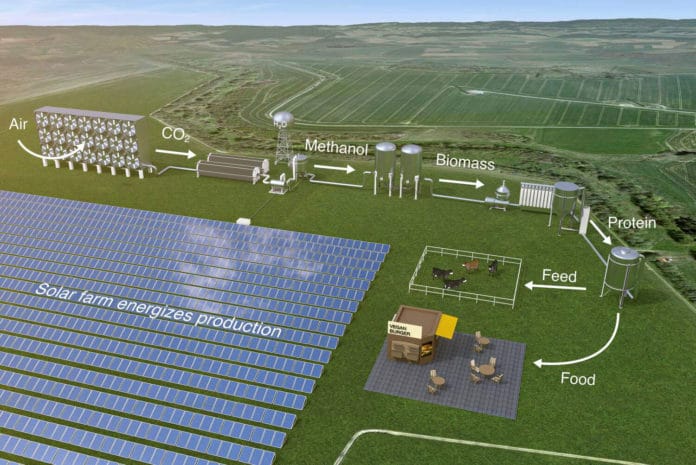The world population is growing rapidly, and in many parts, there is a lack of food. Satisfying their needs with conventional agriculture alone would, however, have an enormous impact on the environment. Microbes play an important role in the production of our food and drinks – from cheese to beer.
An international team of researchers has shown that using solar panels to produce microbial protein – which is rich not just in proteins but also in other nutrients – is more sustainable, efficient, and environmentally friendly than growing conventional crops. The microbial protein farming method uses solar energy, land, nutrients, and carbon dioxide from the air.
For the new study, a team led by scientists at Göttingen University modeled large-scale microbial food production facilities, which use solar energy, air, water, and nutrients to grow microbes. Carbon dioxide is captured directly from the air and, using electricity supplied from solar cells, converted into food for microbes in a bioreactor. The protein-rich biomass is then harvested and processed into a powder that can be used as feed for animals and as food for people, according to the researchers.
The team analyzed the energy requirement for each individual production step, from the very start to the end product, taking into account: photovoltaic power generation, electrochemical production of the high-energy substrate for the microbes, microbe cultivation, harvesting, and processing the protein-rich biomass. Several types of microbes and growth strategies were compared in order to develop the most efficient method.
Researchers found that the solar-powered microbes require only 10% of the land area for every kilogram of protein produced, compared to even the most efficient plant crop – soybean. Water use is also reduced, and the need for fertilizer is removed entirely. Importantly, microbial farms could also be located in regions not suitable for traditional agriculture, such as deserts. The models even showed that the system was still efficient enough at higher latitudes where there isn’t as much sunlight available.
“We expect that microbial protein will also be beneficial as a supplement to our diets since it provides a high-quality protein source composed of all essential amino acids, as well as vitamins and minerals,” explains Dorian Leger, first author of the study. “This technology has the potential to support food production while preventing damage to the environment. Current farming methods contribute to polluted ecosystems and depleted water reserves worldwide.“
Currently, 30-40% of the Earth’s land area is used for agriculture, and yet one in ten people is undernourished. Leger says, “Integrating the cultivation of nutrient-rich microbes with renewable energy systems, such as solar panels, has the potential to produce more food with less resources. This could free up vast amounts of agricultural land, and, in addition, prevent the further destruction of natural ecosystems, thereby making a valuable contribution to conservation and sustainability whilst promoting food availability globally.“
These results suggest that microbial foods could substantially contribute to feeding a growing population and can assist in allocating future limited land resources.
Journal Reference:
- Photovoltaic-driven microbial protein production can use land and sunlight more efficiently than conventional crops. DOI: 10.1073/pnas.2015025118
